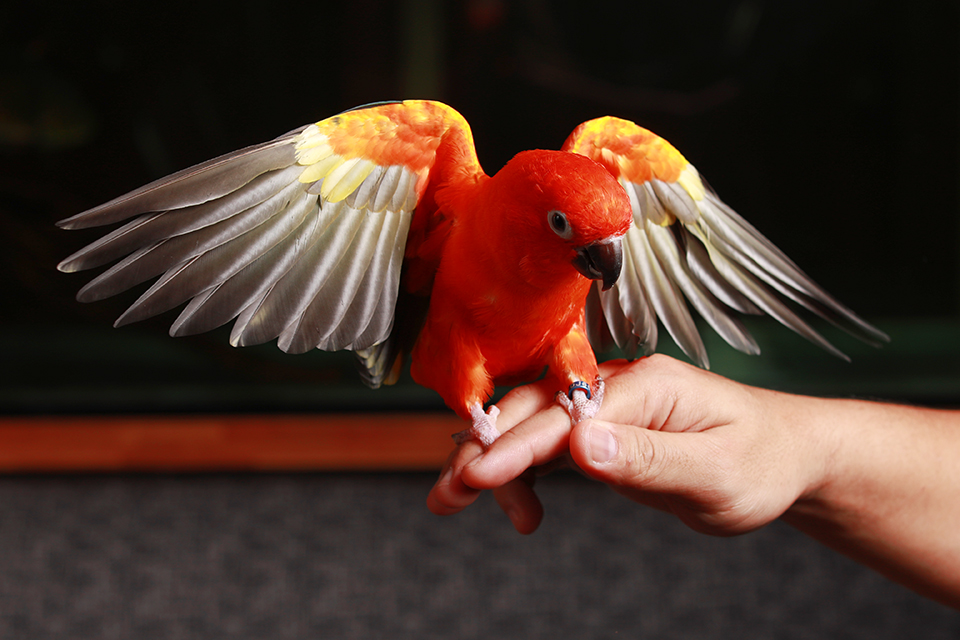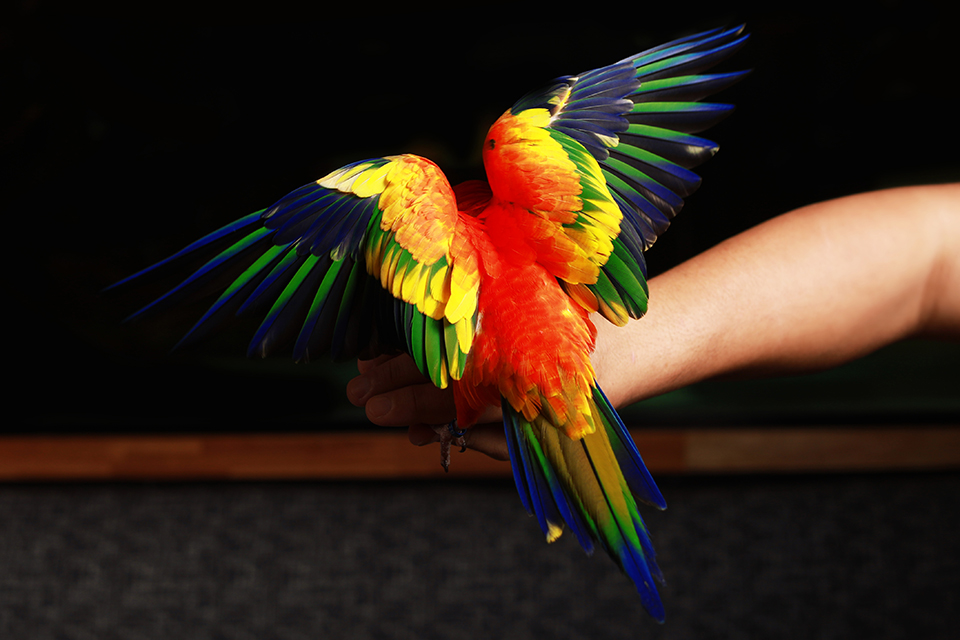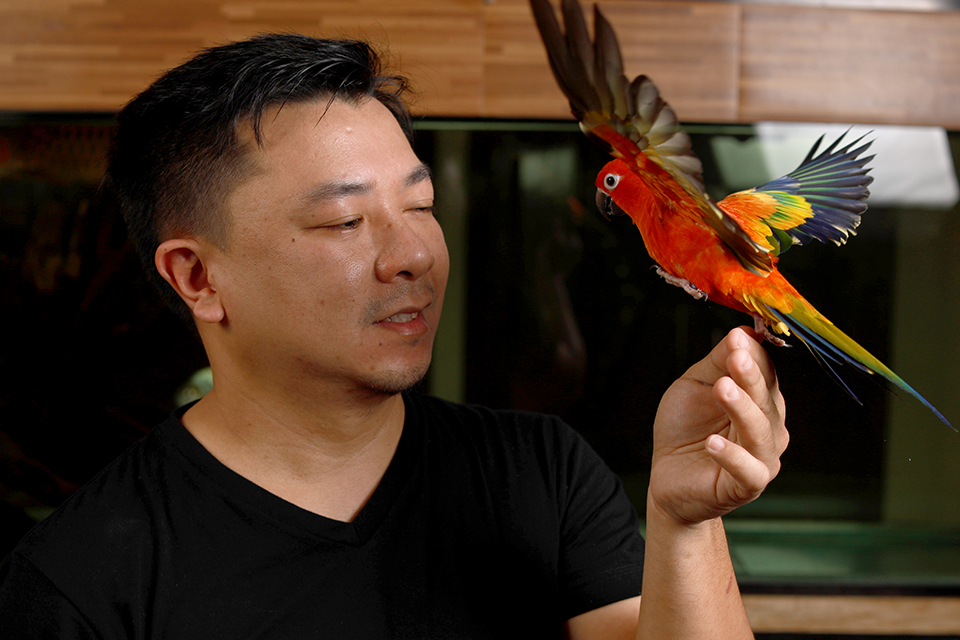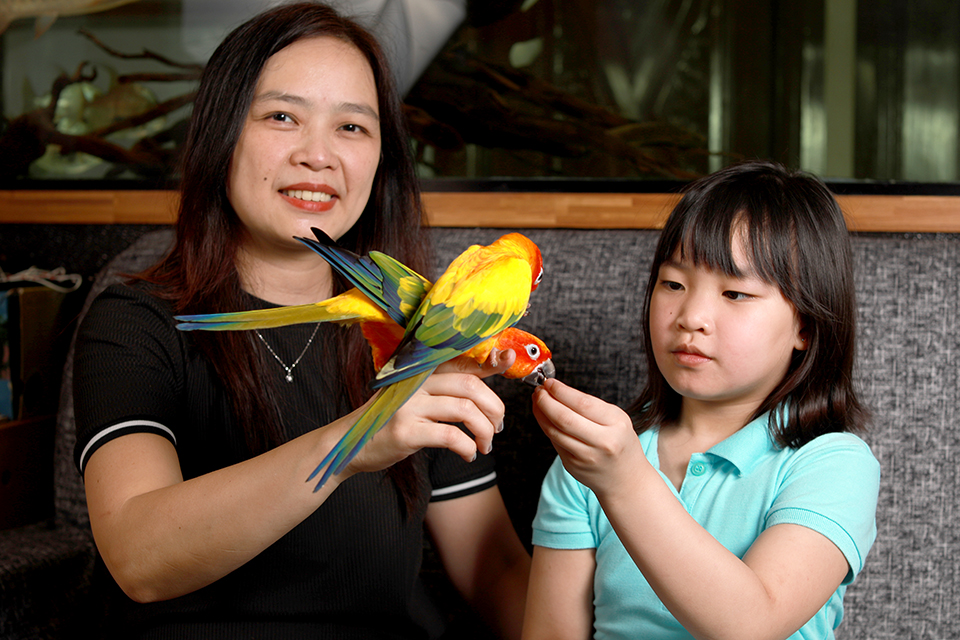THE AMAZING RED FACTOR SUN CONURE RED FACTOR
Birds are pretty amazing. They have wings. They can fly. They can poop in the air. And some could even talk. Obviously, parrots have the upper hand in chitchat since they could mimic sounds that humans make.
Then again, what really strikes us about birds is the color of their feathers. It makes sense, because it’s the first thing we notice when we look at them. Though this sounds superficial, the Red Factor Sun Conure makes this assumption totally understandable. Why? Because anyone who sees them is immediately mesmerized.

HISTORY IN SHADES OF RED
The Sun Conure is a native of South America, particularly Venezuela, in the Northern region of Brazil, and Guyana. Considered as tropical birds, they thrive in woodland and coastal areas as well as savannahs.
According to research, they nest on palm groves and fruit-bearing trees. They are considered parrots – specifically parakeets, which are a smaller kind of parrot. They can also travel long distances and in groups ranging between 15 to 30.
The “Red Factor” Sun Conure is considered a rare type of Sun Conure due to their more vibrant colors, particularly on the head. While Sun Conures typically have typically yellowish to light orange hues, the Red Factor is stunningly ablaze with a fiery shade of red. It is what notably makes them stand out in a nest of more common Sun Conures.
RED FLAG
In 1992, the US and European Union banned the trade for Sun Conures. Because of rampant capture and trading, the population of Sun Conures continues to dwindle as roughly 800,000 parrots, including Sun Conures, are taken from the wild.
As of 2008, they are labeled as an endangered species by the International Union for Conservation of Nature. Hunting for domestic breeding remains the strongest threat to their decreasing population in the wild.

MEET THE GLORIOUS RED
“She has a beautiful color. Majestic High Red,” Rick Espiritu told us in an interview. For three years, Espiritu has been taking care of Red, a Red Factor Sun Conure who is living in the Philippines.
According to him, Red’s unique coloration was the first thing that caught his attention. While Espiritu has a lot of birds living with him in his home, Red has a special place in his heart.
Espiritu’s kids also adore Red. When they were growing up, he says, he slowly introduced his children to Red. Since Red has a loving personality, she has grown to like having Espiritu’s kids around to play and spend time with her.
“My children share in my passion of taking care of Red,” Espiritu expressed. Allowing his kids to feed Red and the other birds in their household is what accustomed them to the avians. “Hopefully, they can manage taking care of Red even in the future.”
Like any other animal companion, Sun Conures can also act out when provoked or suddenly interacted with. If you poke them out of the blue, a stinging bite back is a guarantee. Just like humans, they need to go through the phase of getting-to-know-you. Nobody wants to everybody’s friend right away. A good piece of advice, bird-related or not: Easy does it.

VIBRANT PERSONALITY
It seems that the scarlet-ish color of Red represented more than just her feathers. Red was described to be a playful and active bird, which also reflects the personality of regular Sun Conures. They are active birds, which means they don’t wanna spend their days perched on wood or housed in cages (not that any bird wants to be caged, according to the poet Maya Angelou).
Sun Conures are also described to be athletic birds – not in the human sense that they want to do weightlifting or running, but that they can easily perform tricks if trained properly. Sun Conures are incredibly smart and social, which means interaction with them from a very young age is vital. If you have kids at home and you want them to be around a Sun Conure, patience is an important virtue since Sun Conures have this so-called social barrier before they actually get comfortable with anyone.

RAINBOW OF COLORS
Typically, Sun Conures have a yellow to orange-colored crowns. What is unique about the Red Factor is that there is a more pronounced tint of red on their heads and chest area. Their body colors range from cool yellow to bright orange with hints of blue and green. Complementing this colorful palette, their eyes are surrounded by a white ring, which gives new meaning to the expression, “I’ve got my eyes on you.
”Their tails are usually a calmer shade of green with the tips shaded blue. They have black beaks. And when they fly, their underwing-coverts are usually dark from where we can see them.
When we see them in flight across a clear sky, it’s not hard to imagine that they’ve caught the rainbow on their feathers and wings. Such vibrant colors against a plain cloud or bleak sun would immediately give way to the Majestic High Red.

The environment also plays a big role in the sounds they make. In one instance, a slight change in the color of wall paint can trigger a sound from a Sun Conure.

DID YOU KNOW?
In 1758, the Sun Conure was one of the many species of birds described by renowned Swedish botanist Carl Linnaeus. In the 10th edition of Systema Naturae, Linnaeus called the Sun Conure “Psittacus solstitialis with solstitialis,” meaning “summer solstice” or “sunny” in Latin.
Later on, the Sun Conure’s genus was moved to Aratinga, which is why their scientific name today is called Aratinga solstitialis.
PERKS AND OTHER QUIRKS
Here’s one thing anyone who wants to live with a Red Factor Sun Conure should know: They can be loud as hell. Just as their personality screams social, active, and playful, so does their vocalizations. Now, it can’t be completely curbed, but with care and devotion, one might turn the noises a bit down. With enough attention, the piercing screams can be minimized.
It is said that Sun Conures make rapid and successive noises when they’re not acknowledged or when they are ignored and left alone for long periods of time. How do you know when a Sun Conure feels a little lonely? Don’t worry, they’ll shriek it out for you.
As for the fun part, Sun Conures can also be taught to speak or mimic short words. It is not their best asset, but anyone’s gotta admit that it’s pretty cool that they can copy other sounds, such as microwave buzzers, doorbells, and telephone chimes.

HOW TO CARE FOR A RED FACTOR SUN CONURE
Caring for a Red Factor Sun Conure doesn’t just involve bird seeds and a clean cage. Like any other animal companion, knowing the specifics of care is very important to their well-being.
ENVIRONMENT
According to Espiritu, Red has no problem socializing with other birds in his household. When asked whether a Red Factor Sun Conure can live harmoniously with a dog or a cat, he immediately shot down the possibility. “Dogs? Negative. Especially with cats; there’s no way for them to interact [amicably].” This coincides with Alyson Kalhagen’s caring tip from her 2021 article for The Spruce Pets to make sure that there are “out-of-the-cage” areas for your Sun Counre.
While the cage is recommended to be at least 20 by 20 inches wide and 36 inches high, it is important to take into consideration the roaming-around-space for your Sun Conure. Kalhagen also mentioned that a “play gym” inside a Sun Conure’s cage is essential, as it allows them to learn tricks inside their cages as well as roam around, a.k.a. fly whenever they want to.
In other words, aside from needing the usual cleaning to keep away from pests and diseases, a cage should also be a home to your Red Factor Sun Conure.

EXERCISE
In connection to a Sun Conure’s environment, it is recommended that they get out of their cages for at least 3 hours. This will allow them to fly and play in a bigger space. Since Sun Conures are active and playful, it would only make sense to allow them to release such energy. Remember, a lonely and unnoticed Red Factor Sun Conure loves to make noise.
Free flight or free flying is also encouraged by Espiritu as it creates a bond between him and Red. “In addition to free flight, we also play Recall,” added Espiritu. Recall is an activity which helps Red remember tricks taught to her by Espiritu. Most bird caretakers do this as interactive play, giving treats to their Sun Conures when they perform the designated task or trick.
According to Labefer Company, parrots such as Sun Conures are prone to feather picking. If not given attention or left in boredom, Sun Conures can develop this problem. This is why it is essential to create opportunities for foraging and playing, and not just simply letting them out of their cages.
FOOD
Sun Conures’ diet consists mainly of seeds, vegetables, fruits, and even flowers. It is said that in the wild, they look for and eat berries, a variation of seeds, and pods of legumes.
According to Espiritu, Red’s diet mainly includes sweet potato, carrots, and squash. For fruits, Red likes apples, oranges, and even grapes. Though they thrive on a plant or nut-based diet, Sun Conures also eat bugs from trees that bear fruit.
When giving them vegetables, it is advisable to boil the veggies first for about ten minutes so that the vitamins can come out. Espiritu then told us that he prefers to chop the veggies into bite-sized pieces so that Red can easily digest the food. In the afternoon, she is given seeds or mixed seeds. During play or training, she is awarded almond nuts when she learns a new trick. Sunflower seeds are also a staple for Red.

ADVICE FOR CARETAKERS
LOVE EQUALS TIME
For the most part, our animal companions are stuck with us at home. Unless there is a veterinary appointment, parrots like Red rarely get to spend their time outside with other people or animals.
Since Red Factor Sun Conures like attention, they can often act out when ignored for the better part of the day. It is important for any caretaker to spend time with their birds. It is only one of the many ways we can show our love and appreciation of them.
“My Red is loyal and sweet,” expressed Espiritu in the interview. Just like humans, Red can also exhibit these qualities. Sometimes, Red is moody and can even feel jealousy towards Espiritu’s other bird companions. “When this happens, Red finds ways to get my attention,” he added. During the lockdown, Espiritu told us that Red sometimes accompanies him doing the most mundane things such as watching TV on the sofa. He says now that most work can be done at home, he gets to spend more time with Red.
If there is one thing that the pandemic taught us, it is the feeling of getting stuck. I guess this is how birds feel too in our households. While we get to go out into the world and perform many activities, they can only do so much at home. Our world means a lot of things, but for them, we make up most of their world.
RESPONSIBILITY
MEANS MONEY According to Espiritu, the sale of Sun Conures, especially rare ones like Red who is a Red Factor, is booming. “Many people see Red Factors on Facebook,” he says. “Just because you see it online, it doesn’t mean that you have to get one right away,” he continues.
He also expressed that Red Factors deserve to be cared for and loved, and that means spending money on them so that they can feel comfortable at home. This means that a Red Factor guardian should set aside money for food and shelter, and that that is a monthly responsibility. It is not some trendy thing to acquire Red Factors.
“You know, Sun Conures can live for up to 30-45 years,” he explains. This means that a caretaker or guardian should be ready financially and also be willing to provide whatever a Sun Conure needs. You do not only give your time but also a part of your monthly earnings for a long, long time. “So for anyone who would consider having a Red Factor at home, this is what you have to think about.”
Photos by JEFFREY C. LIM






